Program Design Evaluation and Implementation for Aboriginal Health
VerifiedAdded on 2022/08/22
|7
|1779
|14
Report
AI Summary
This report provides an evaluation of a program designed to address the critical health issues faced by Aboriginal communities in Queensland, with a specific focus on cardiovascular disease. The assignment begins by highlighting the disproportionate burden of cardiovascular disease among Aboriginal populations, emphasizing the need for targeted interventions and improved healthcare access. It explores the importance of needs assessment, differentiating between normative, felt, and expressed needs, and how these apply to the Aboriginal community's requirements for healthcare services, financial counseling, and social support. The report examines the existing challenges, including health inequities, cultural barriers, and social determinants of health such as poverty, lack of nutrition, and inadequate housing, which contribute to poor health outcomes. It also reviews the role of general practitioners (GPs) and the application of SWOT analysis to evaluate the strengths, weaknesses, opportunities, and threats related to delivering healthcare services to Aboriginal populations. The report proposes a shift-based program design to ensure accessible healthcare for working populations at risk of cardiovascular diseases and emphasizes the importance of incorporating strategies that address social, environmental, and economic issues to achieve health equity, referencing relevant literature and policy documents.
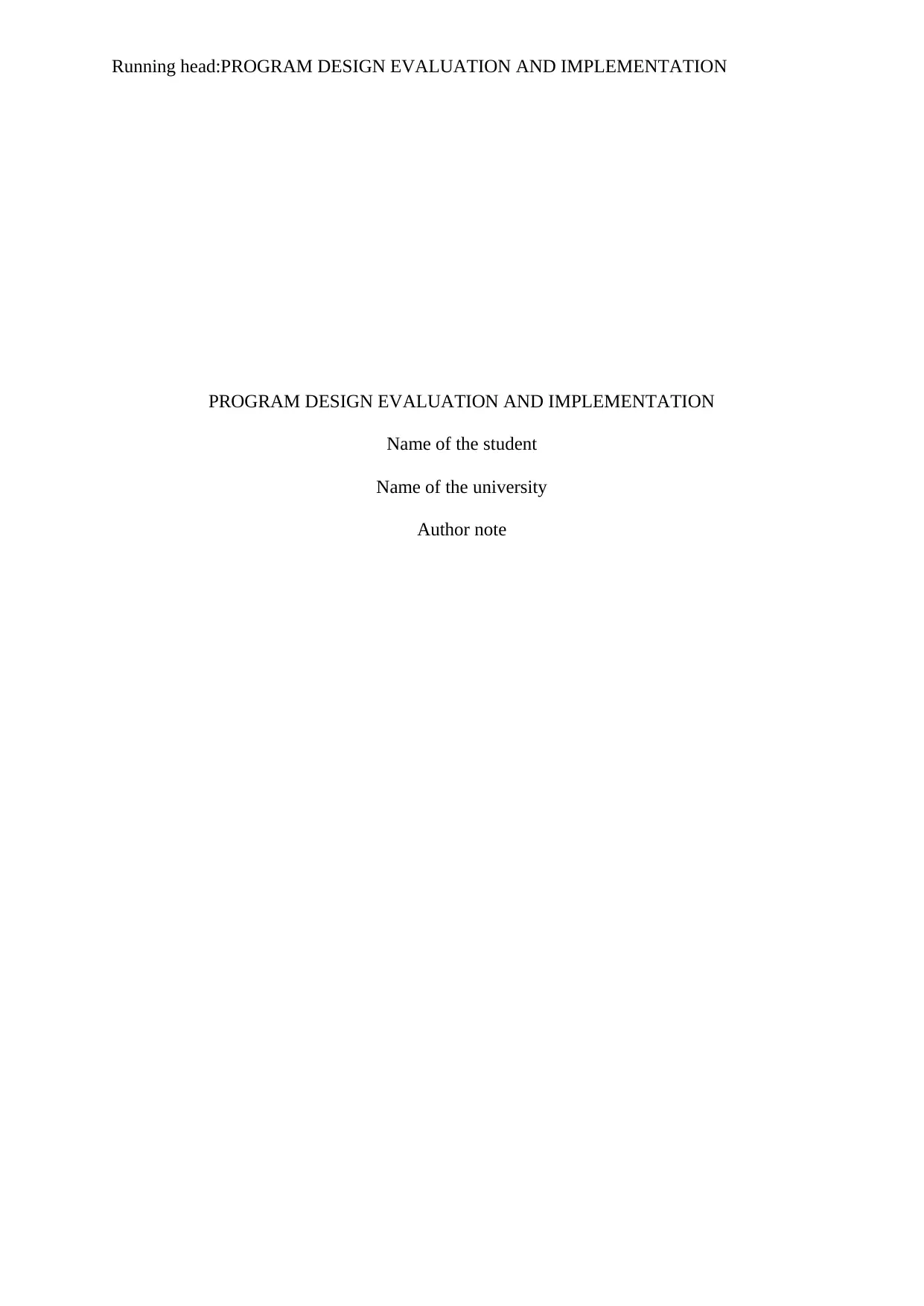
Running head:PROGRAM DESIGN EVALUATION AND IMPLEMENTATION
PROGRAM DESIGN EVALUATION AND IMPLEMENTATION
Name of the student
Name of the university
Author note
PROGRAM DESIGN EVALUATION AND IMPLEMENTATION
Name of the student
Name of the university
Author note
Paraphrase This Document
Need a fresh take? Get an instant paraphrase of this document with our AI Paraphraser
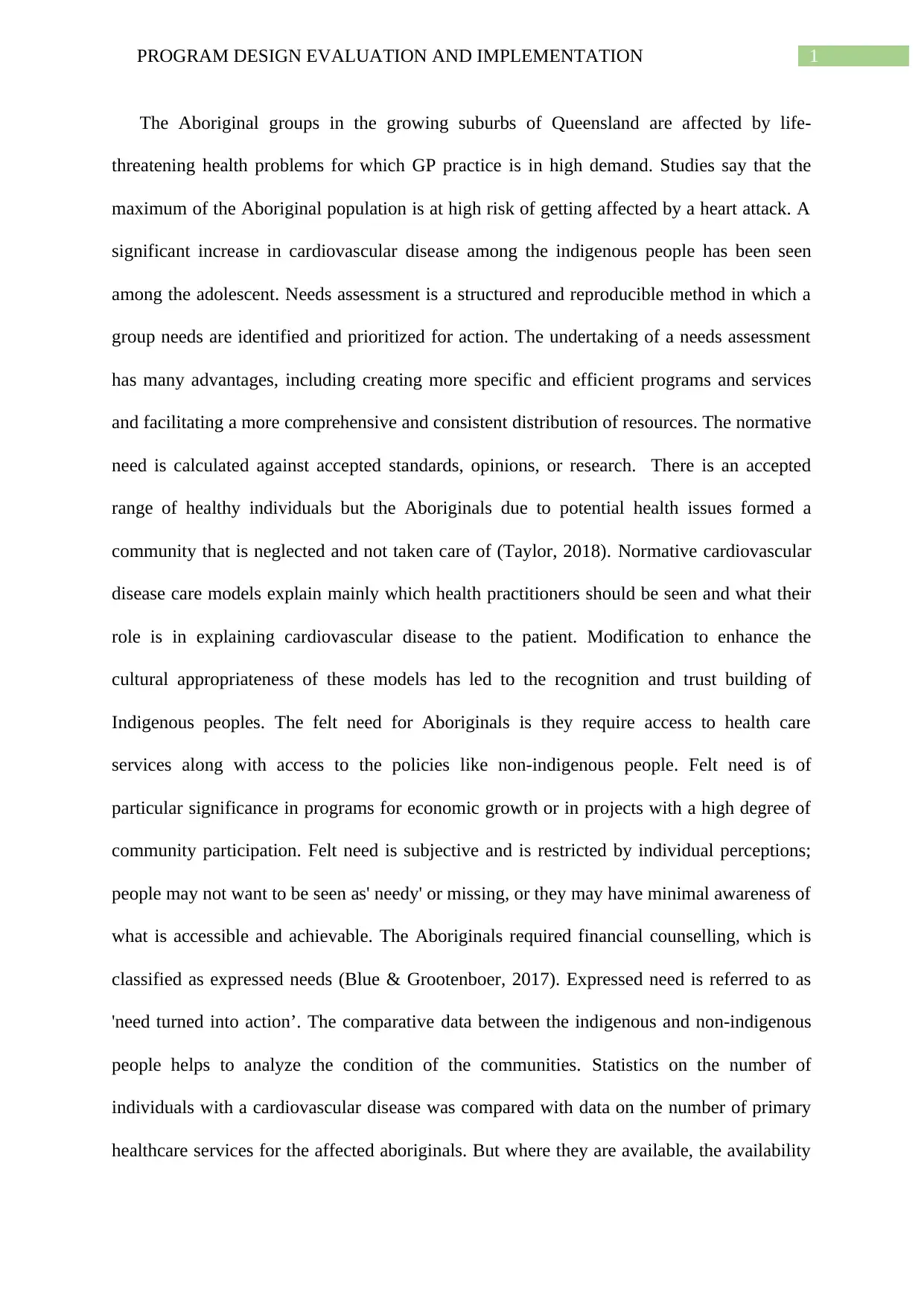
1PROGRAM DESIGN EVALUATION AND IMPLEMENTATION
The Aboriginal groups in the growing suburbs of Queensland are affected by life-
threatening health problems for which GP practice is in high demand. Studies say that the
maximum of the Aboriginal population is at high risk of getting affected by a heart attack. A
significant increase in cardiovascular disease among the indigenous people has been seen
among the adolescent. Needs assessment is a structured and reproducible method in which a
group needs are identified and prioritized for action. The undertaking of a needs assessment
has many advantages, including creating more specific and efficient programs and services
and facilitating a more comprehensive and consistent distribution of resources. The normative
need is calculated against accepted standards, opinions, or research. There is an accepted
range of healthy individuals but the Aboriginals due to potential health issues formed a
community that is neglected and not taken care of (Taylor, 2018). Normative cardiovascular
disease care models explain mainly which health practitioners should be seen and what their
role is in explaining cardiovascular disease to the patient. Modification to enhance the
cultural appropriateness of these models has led to the recognition and trust building of
Indigenous peoples. The felt need for Aboriginals is they require access to health care
services along with access to the policies like non-indigenous people. Felt need is of
particular significance in programs for economic growth or in projects with a high degree of
community participation. Felt need is subjective and is restricted by individual perceptions;
people may not want to be seen as' needy' or missing, or they may have minimal awareness of
what is accessible and achievable. The Aboriginals required financial counselling, which is
classified as expressed needs (Blue & Grootenboer, 2017). Expressed need is referred to as
'need turned into action’. The comparative data between the indigenous and non-indigenous
people helps to analyze the condition of the communities. Statistics on the number of
individuals with a cardiovascular disease was compared with data on the number of primary
healthcare services for the affected aboriginals. But where they are available, the availability
The Aboriginal groups in the growing suburbs of Queensland are affected by life-
threatening health problems for which GP practice is in high demand. Studies say that the
maximum of the Aboriginal population is at high risk of getting affected by a heart attack. A
significant increase in cardiovascular disease among the indigenous people has been seen
among the adolescent. Needs assessment is a structured and reproducible method in which a
group needs are identified and prioritized for action. The undertaking of a needs assessment
has many advantages, including creating more specific and efficient programs and services
and facilitating a more comprehensive and consistent distribution of resources. The normative
need is calculated against accepted standards, opinions, or research. There is an accepted
range of healthy individuals but the Aboriginals due to potential health issues formed a
community that is neglected and not taken care of (Taylor, 2018). Normative cardiovascular
disease care models explain mainly which health practitioners should be seen and what their
role is in explaining cardiovascular disease to the patient. Modification to enhance the
cultural appropriateness of these models has led to the recognition and trust building of
Indigenous peoples. The felt need for Aboriginals is they require access to health care
services along with access to the policies like non-indigenous people. Felt need is of
particular significance in programs for economic growth or in projects with a high degree of
community participation. Felt need is subjective and is restricted by individual perceptions;
people may not want to be seen as' needy' or missing, or they may have minimal awareness of
what is accessible and achievable. The Aboriginals required financial counselling, which is
classified as expressed needs (Blue & Grootenboer, 2017). Expressed need is referred to as
'need turned into action’. The comparative data between the indigenous and non-indigenous
people helps to analyze the condition of the communities. Statistics on the number of
individuals with a cardiovascular disease was compared with data on the number of primary
healthcare services for the affected aboriginals. But where they are available, the availability
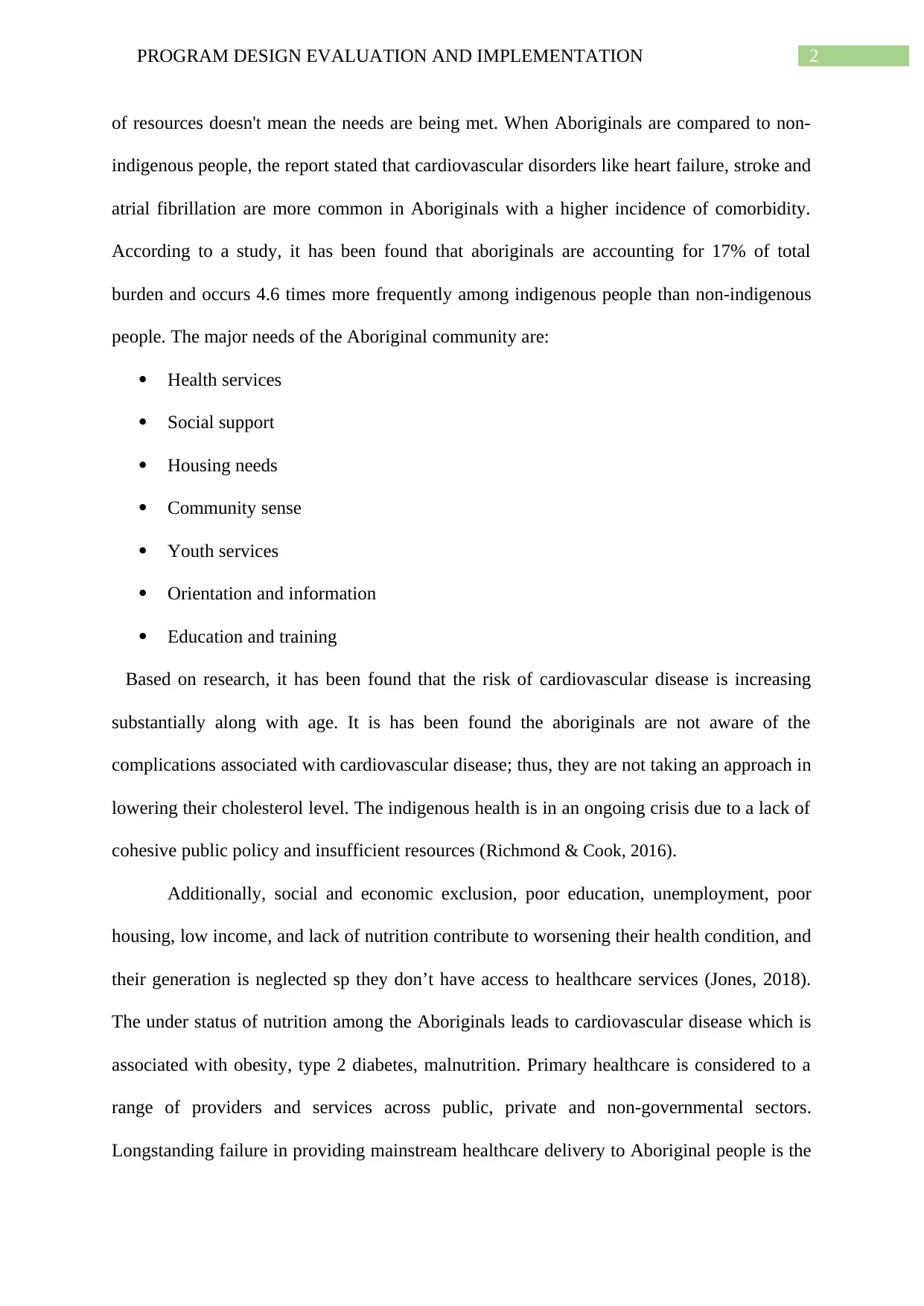
2PROGRAM DESIGN EVALUATION AND IMPLEMENTATION
of resources doesn't mean the needs are being met. When Aboriginals are compared to non-
indigenous people, the report stated that cardiovascular disorders like heart failure, stroke and
atrial fibrillation are more common in Aboriginals with a higher incidence of comorbidity.
According to a study, it has been found that aboriginals are accounting for 17% of total
burden and occurs 4.6 times more frequently among indigenous people than non-indigenous
people. The major needs of the Aboriginal community are:
Health services
Social support
Housing needs
Community sense
Youth services
Orientation and information
Education and training
Based on research, it has been found that the risk of cardiovascular disease is increasing
substantially along with age. It is has been found the aboriginals are not aware of the
complications associated with cardiovascular disease; thus, they are not taking an approach in
lowering their cholesterol level. The indigenous health is in an ongoing crisis due to a lack of
cohesive public policy and insufficient resources (Richmond & Cook, 2016).
Additionally, social and economic exclusion, poor education, unemployment, poor
housing, low income, and lack of nutrition contribute to worsening their health condition, and
their generation is neglected sp they don’t have access to healthcare services (Jones, 2018).
The under status of nutrition among the Aboriginals leads to cardiovascular disease which is
associated with obesity, type 2 diabetes, malnutrition. Primary healthcare is considered to a
range of providers and services across public, private and non-governmental sectors.
Longstanding failure in providing mainstream healthcare delivery to Aboriginal people is the
of resources doesn't mean the needs are being met. When Aboriginals are compared to non-
indigenous people, the report stated that cardiovascular disorders like heart failure, stroke and
atrial fibrillation are more common in Aboriginals with a higher incidence of comorbidity.
According to a study, it has been found that aboriginals are accounting for 17% of total
burden and occurs 4.6 times more frequently among indigenous people than non-indigenous
people. The major needs of the Aboriginal community are:
Health services
Social support
Housing needs
Community sense
Youth services
Orientation and information
Education and training
Based on research, it has been found that the risk of cardiovascular disease is increasing
substantially along with age. It is has been found the aboriginals are not aware of the
complications associated with cardiovascular disease; thus, they are not taking an approach in
lowering their cholesterol level. The indigenous health is in an ongoing crisis due to a lack of
cohesive public policy and insufficient resources (Richmond & Cook, 2016).
Additionally, social and economic exclusion, poor education, unemployment, poor
housing, low income, and lack of nutrition contribute to worsening their health condition, and
their generation is neglected sp they don’t have access to healthcare services (Jones, 2018).
The under status of nutrition among the Aboriginals leads to cardiovascular disease which is
associated with obesity, type 2 diabetes, malnutrition. Primary healthcare is considered to a
range of providers and services across public, private and non-governmental sectors.
Longstanding failure in providing mainstream healthcare delivery to Aboriginal people is the
⊘ This is a preview!⊘
Do you want full access?
Subscribe today to unlock all pages.

Trusted by 1+ million students worldwide
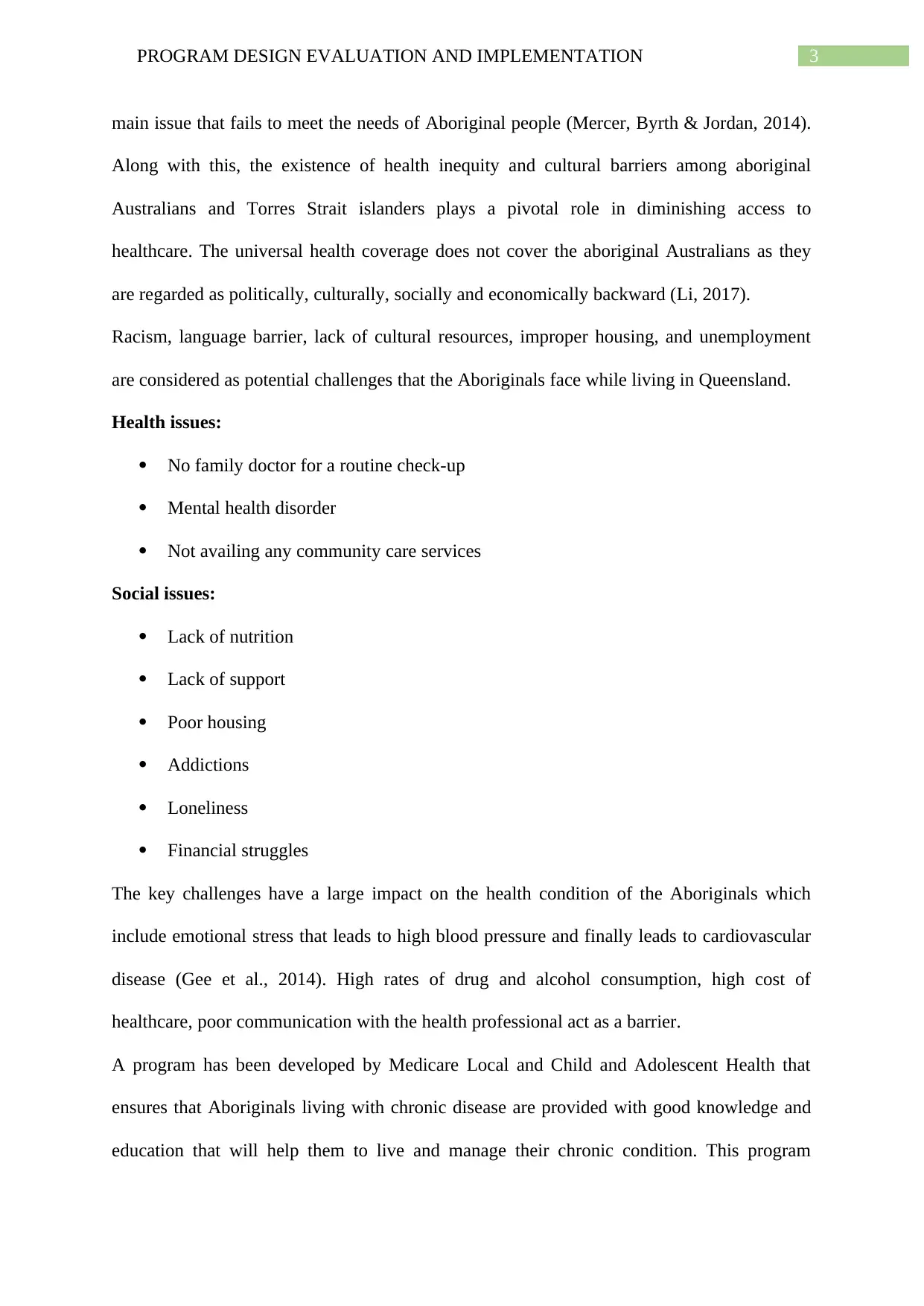
3PROGRAM DESIGN EVALUATION AND IMPLEMENTATION
main issue that fails to meet the needs of Aboriginal people (Mercer, Byrth & Jordan, 2014).
Along with this, the existence of health inequity and cultural barriers among aboriginal
Australians and Torres Strait islanders plays a pivotal role in diminishing access to
healthcare. The universal health coverage does not cover the aboriginal Australians as they
are regarded as politically, culturally, socially and economically backward (Li, 2017).
Racism, language barrier, lack of cultural resources, improper housing, and unemployment
are considered as potential challenges that the Aboriginals face while living in Queensland.
Health issues:
No family doctor for a routine check-up
Mental health disorder
Not availing any community care services
Social issues:
Lack of nutrition
Lack of support
Poor housing
Addictions
Loneliness
Financial struggles
The key challenges have a large impact on the health condition of the Aboriginals which
include emotional stress that leads to high blood pressure and finally leads to cardiovascular
disease (Gee et al., 2014). High rates of drug and alcohol consumption, high cost of
healthcare, poor communication with the health professional act as a barrier.
A program has been developed by Medicare Local and Child and Adolescent Health that
ensures that Aboriginals living with chronic disease are provided with good knowledge and
education that will help them to live and manage their chronic condition. This program
main issue that fails to meet the needs of Aboriginal people (Mercer, Byrth & Jordan, 2014).
Along with this, the existence of health inequity and cultural barriers among aboriginal
Australians and Torres Strait islanders plays a pivotal role in diminishing access to
healthcare. The universal health coverage does not cover the aboriginal Australians as they
are regarded as politically, culturally, socially and economically backward (Li, 2017).
Racism, language barrier, lack of cultural resources, improper housing, and unemployment
are considered as potential challenges that the Aboriginals face while living in Queensland.
Health issues:
No family doctor for a routine check-up
Mental health disorder
Not availing any community care services
Social issues:
Lack of nutrition
Lack of support
Poor housing
Addictions
Loneliness
Financial struggles
The key challenges have a large impact on the health condition of the Aboriginals which
include emotional stress that leads to high blood pressure and finally leads to cardiovascular
disease (Gee et al., 2014). High rates of drug and alcohol consumption, high cost of
healthcare, poor communication with the health professional act as a barrier.
A program has been developed by Medicare Local and Child and Adolescent Health that
ensures that Aboriginals living with chronic disease are provided with good knowledge and
education that will help them to live and manage their chronic condition. This program
Paraphrase This Document
Need a fresh take? Get an instant paraphrase of this document with our AI Paraphraser
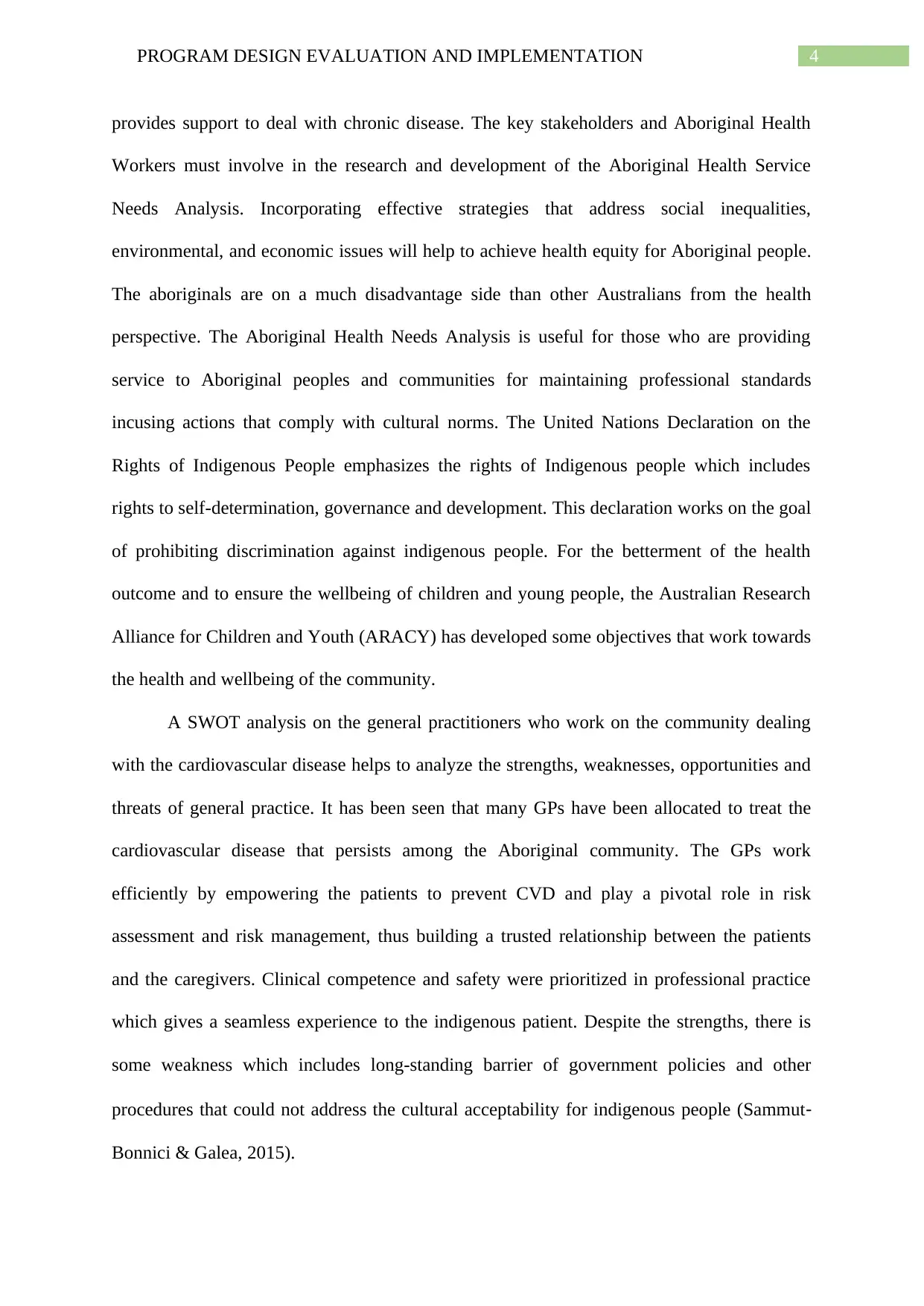
4PROGRAM DESIGN EVALUATION AND IMPLEMENTATION
provides support to deal with chronic disease. The key stakeholders and Aboriginal Health
Workers must involve in the research and development of the Aboriginal Health Service
Needs Analysis. Incorporating effective strategies that address social inequalities,
environmental, and economic issues will help to achieve health equity for Aboriginal people.
The aboriginals are on a much disadvantage side than other Australians from the health
perspective. The Aboriginal Health Needs Analysis is useful for those who are providing
service to Aboriginal peoples and communities for maintaining professional standards
incusing actions that comply with cultural norms. The United Nations Declaration on the
Rights of Indigenous People emphasizes the rights of Indigenous people which includes
rights to self-determination, governance and development. This declaration works on the goal
of prohibiting discrimination against indigenous people. For the betterment of the health
outcome and to ensure the wellbeing of children and young people, the Australian Research
Alliance for Children and Youth (ARACY) has developed some objectives that work towards
the health and wellbeing of the community.
A SWOT analysis on the general practitioners who work on the community dealing
with the cardiovascular disease helps to analyze the strengths, weaknesses, opportunities and
threats of general practice. It has been seen that many GPs have been allocated to treat the
cardiovascular disease that persists among the Aboriginal community. The GPs work
efficiently by empowering the patients to prevent CVD and play a pivotal role in risk
assessment and risk management, thus building a trusted relationship between the patients
and the caregivers. Clinical competence and safety were prioritized in professional practice
which gives a seamless experience to the indigenous patient. Despite the strengths, there is
some weakness which includes long-standing barrier of government policies and other
procedures that could not address the cultural acceptability for indigenous people (Sammut‐
Bonnici & Galea, 2015).
provides support to deal with chronic disease. The key stakeholders and Aboriginal Health
Workers must involve in the research and development of the Aboriginal Health Service
Needs Analysis. Incorporating effective strategies that address social inequalities,
environmental, and economic issues will help to achieve health equity for Aboriginal people.
The aboriginals are on a much disadvantage side than other Australians from the health
perspective. The Aboriginal Health Needs Analysis is useful for those who are providing
service to Aboriginal peoples and communities for maintaining professional standards
incusing actions that comply with cultural norms. The United Nations Declaration on the
Rights of Indigenous People emphasizes the rights of Indigenous people which includes
rights to self-determination, governance and development. This declaration works on the goal
of prohibiting discrimination against indigenous people. For the betterment of the health
outcome and to ensure the wellbeing of children and young people, the Australian Research
Alliance for Children and Youth (ARACY) has developed some objectives that work towards
the health and wellbeing of the community.
A SWOT analysis on the general practitioners who work on the community dealing
with the cardiovascular disease helps to analyze the strengths, weaknesses, opportunities and
threats of general practice. It has been seen that many GPs have been allocated to treat the
cardiovascular disease that persists among the Aboriginal community. The GPs work
efficiently by empowering the patients to prevent CVD and play a pivotal role in risk
assessment and risk management, thus building a trusted relationship between the patients
and the caregivers. Clinical competence and safety were prioritized in professional practice
which gives a seamless experience to the indigenous patient. Despite the strengths, there is
some weakness which includes long-standing barrier of government policies and other
procedures that could not address the cultural acceptability for indigenous people (Sammut‐
Bonnici & Galea, 2015).
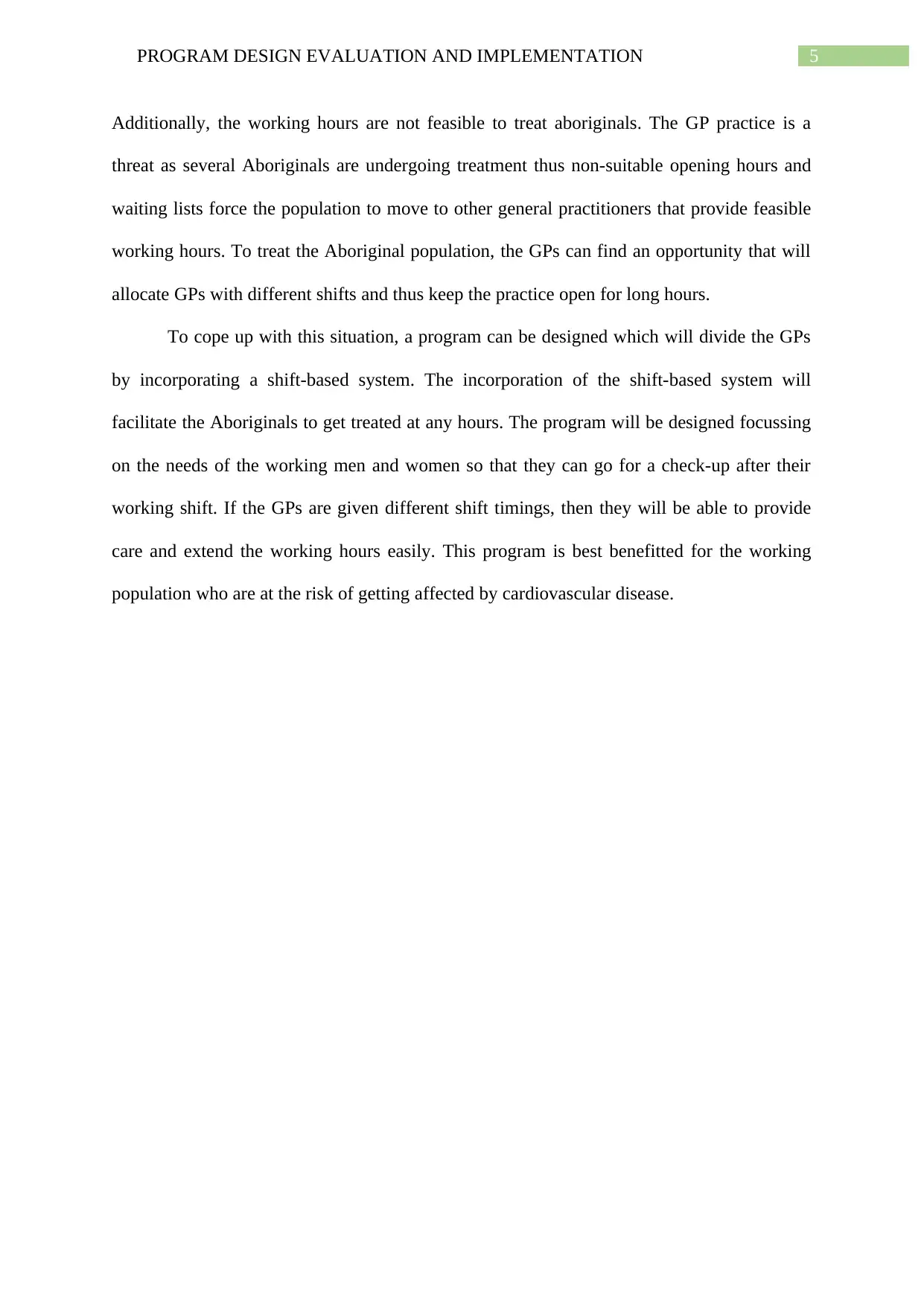
5PROGRAM DESIGN EVALUATION AND IMPLEMENTATION
Additionally, the working hours are not feasible to treat aboriginals. The GP practice is a
threat as several Aboriginals are undergoing treatment thus non-suitable opening hours and
waiting lists force the population to move to other general practitioners that provide feasible
working hours. To treat the Aboriginal population, the GPs can find an opportunity that will
allocate GPs with different shifts and thus keep the practice open for long hours.
To cope up with this situation, a program can be designed which will divide the GPs
by incorporating a shift-based system. The incorporation of the shift-based system will
facilitate the Aboriginals to get treated at any hours. The program will be designed focussing
on the needs of the working men and women so that they can go for a check-up after their
working shift. If the GPs are given different shift timings, then they will be able to provide
care and extend the working hours easily. This program is best benefitted for the working
population who are at the risk of getting affected by cardiovascular disease.
Additionally, the working hours are not feasible to treat aboriginals. The GP practice is a
threat as several Aboriginals are undergoing treatment thus non-suitable opening hours and
waiting lists force the population to move to other general practitioners that provide feasible
working hours. To treat the Aboriginal population, the GPs can find an opportunity that will
allocate GPs with different shifts and thus keep the practice open for long hours.
To cope up with this situation, a program can be designed which will divide the GPs
by incorporating a shift-based system. The incorporation of the shift-based system will
facilitate the Aboriginals to get treated at any hours. The program will be designed focussing
on the needs of the working men and women so that they can go for a check-up after their
working shift. If the GPs are given different shift timings, then they will be able to provide
care and extend the working hours easily. This program is best benefitted for the working
population who are at the risk of getting affected by cardiovascular disease.
⊘ This is a preview!⊘
Do you want full access?
Subscribe today to unlock all pages.

Trusted by 1+ million students worldwide
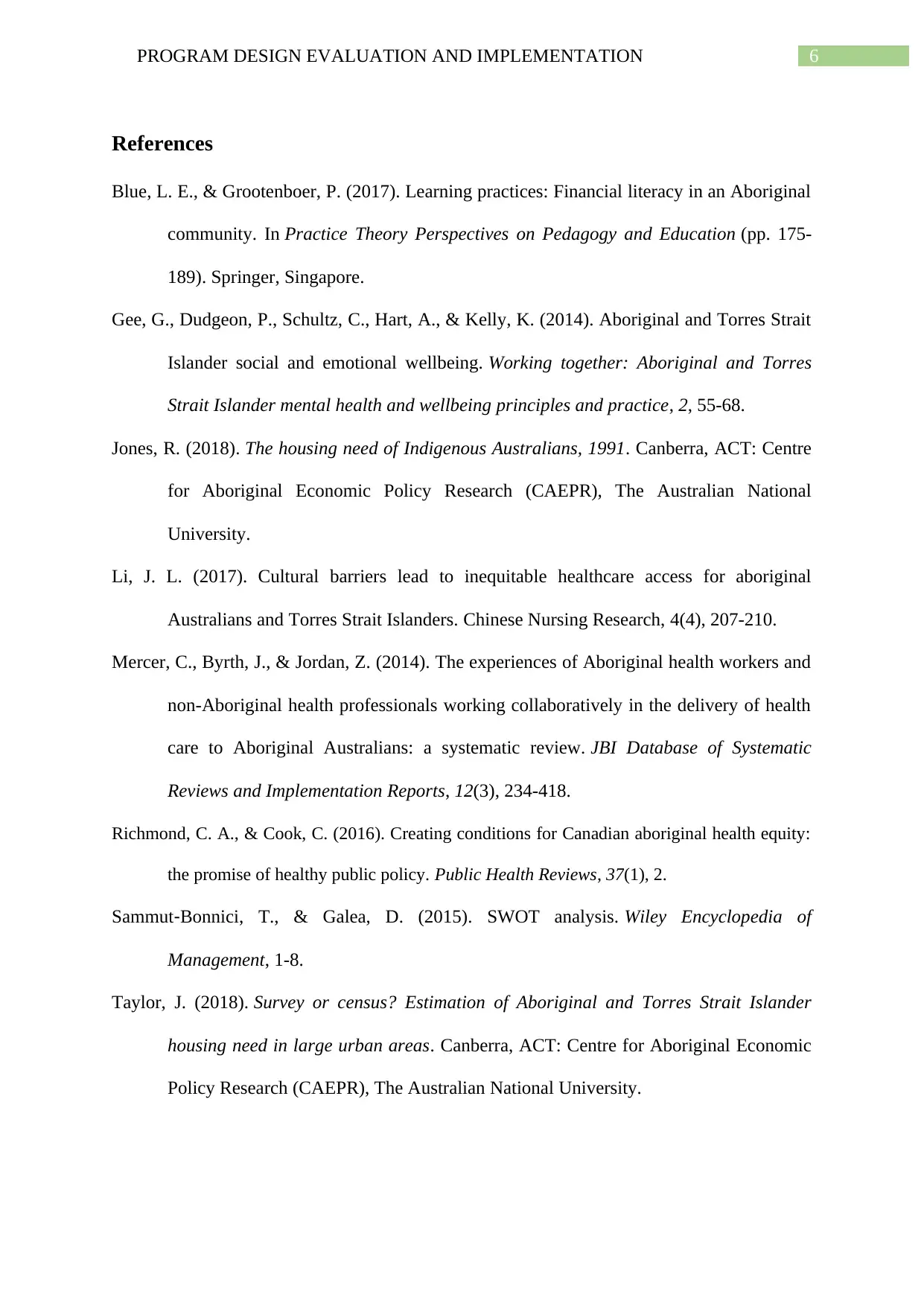
6PROGRAM DESIGN EVALUATION AND IMPLEMENTATION
References
Blue, L. E., & Grootenboer, P. (2017). Learning practices: Financial literacy in an Aboriginal
community. In Practice Theory Perspectives on Pedagogy and Education (pp. 175-
189). Springer, Singapore.
Gee, G., Dudgeon, P., Schultz, C., Hart, A., & Kelly, K. (2014). Aboriginal and Torres Strait
Islander social and emotional wellbeing. Working together: Aboriginal and Torres
Strait Islander mental health and wellbeing principles and practice, 2, 55-68.
Jones, R. (2018). The housing need of Indigenous Australians, 1991. Canberra, ACT: Centre
for Aboriginal Economic Policy Research (CAEPR), The Australian National
University.
Li, J. L. (2017). Cultural barriers lead to inequitable healthcare access for aboriginal
Australians and Torres Strait Islanders. Chinese Nursing Research, 4(4), 207-210.
Mercer, C., Byrth, J., & Jordan, Z. (2014). The experiences of Aboriginal health workers and
non-Aboriginal health professionals working collaboratively in the delivery of health
care to Aboriginal Australians: a systematic review. JBI Database of Systematic
Reviews and Implementation Reports, 12(3), 234-418.
Richmond, C. A., & Cook, C. (2016). Creating conditions for Canadian aboriginal health equity:
the promise of healthy public policy. Public Health Reviews, 37(1), 2.
Sammut‐Bonnici, T., & Galea, D. (2015). SWOT analysis. Wiley Encyclopedia of
Management, 1-8.
Taylor, J. (2018). Survey or census? Estimation of Aboriginal and Torres Strait Islander
housing need in large urban areas. Canberra, ACT: Centre for Aboriginal Economic
Policy Research (CAEPR), The Australian National University.
References
Blue, L. E., & Grootenboer, P. (2017). Learning practices: Financial literacy in an Aboriginal
community. In Practice Theory Perspectives on Pedagogy and Education (pp. 175-
189). Springer, Singapore.
Gee, G., Dudgeon, P., Schultz, C., Hart, A., & Kelly, K. (2014). Aboriginal and Torres Strait
Islander social and emotional wellbeing. Working together: Aboriginal and Torres
Strait Islander mental health and wellbeing principles and practice, 2, 55-68.
Jones, R. (2018). The housing need of Indigenous Australians, 1991. Canberra, ACT: Centre
for Aboriginal Economic Policy Research (CAEPR), The Australian National
University.
Li, J. L. (2017). Cultural barriers lead to inequitable healthcare access for aboriginal
Australians and Torres Strait Islanders. Chinese Nursing Research, 4(4), 207-210.
Mercer, C., Byrth, J., & Jordan, Z. (2014). The experiences of Aboriginal health workers and
non-Aboriginal health professionals working collaboratively in the delivery of health
care to Aboriginal Australians: a systematic review. JBI Database of Systematic
Reviews and Implementation Reports, 12(3), 234-418.
Richmond, C. A., & Cook, C. (2016). Creating conditions for Canadian aboriginal health equity:
the promise of healthy public policy. Public Health Reviews, 37(1), 2.
Sammut‐Bonnici, T., & Galea, D. (2015). SWOT analysis. Wiley Encyclopedia of
Management, 1-8.
Taylor, J. (2018). Survey or census? Estimation of Aboriginal and Torres Strait Islander
housing need in large urban areas. Canberra, ACT: Centre for Aboriginal Economic
Policy Research (CAEPR), The Australian National University.
1 out of 7
Related Documents
Your All-in-One AI-Powered Toolkit for Academic Success.
+13062052269
info@desklib.com
Available 24*7 on WhatsApp / Email
![[object Object]](/_next/static/media/star-bottom.7253800d.svg)
Unlock your academic potential
Copyright © 2020–2025 A2Z Services. All Rights Reserved. Developed and managed by ZUCOL.





